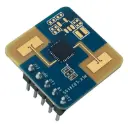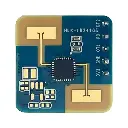Radar Sensor Module 3.3V – Low Power HLK-LD2410S
HLK‑LD2410S 24 GHz Radar Presence Sensor Module – 3.3 V, Low Power
Overview
The HLK-LD2410S is a compact millimeter-wave radar sensor designed for ultra-low power human presence detection. It uses 24 GHz FMCW radar and onboard algorithms to sense motion and micro-movements (e.g., breathing) at distances up to 8 m, all while drawing minimal current (~0.1–0.45 mA depending on update rate)
Key Features
Plug-and-play device with I²C ultralow current modes
Detects static and moving people—reacts to micro-movements like breathing
Sensing range: up to 8 m; angle coverage ±60° when wall-mounted
Built‑in FMCW radar + digital algorithm in a ~20 × 20 mm PCB
Interfaces: GPIO pulse output or UART serial
Low-power operation suitable for battery-powered or IoT applications
Technical Specifications
| Parameter | Value |
|---|---|
| Operating Frequency | 24–24.25 GHz ISM |
| Supply Voltage | 3.0–3.6 V (typical 3.3 V) |
| Average Current | ~0.1 mA @ 1 Hz refresh; ~0.45 mA @ max rate |
| Power Consumption | Ultra-low |
| Detection Range | 0.2 m (min) – 8 m (max) |
| Angular Coverage | ±60° (wall-mounted) |
| Output Modes | GPIO (motion/no-motion) or serial UART |
| Dimensions | ~20 × 20 mm PCB |
Wiring (3.3 V or 5 V MCU)
VCC → 3.3 V regulated supply
GND → Ground
GPIO → Input for motion detection pulse
UART Tx/Rx → Optional data mode (requires serial connection)
Use visual configuration tool (available from manufacturer) to adjust sensing zones, thresholds, and hold time.
Applications
Smart lighting and HVAC presence sensing
Security and occupancy detection
Energy-saving human detection switches
Wearable or portable battery-powered sensors
Advanced automation with precise micro-movement sensing



